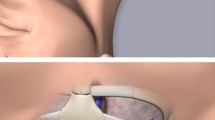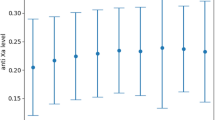Abstract
Objectives
To investigate the advantages and disadvantages of Totally implantable venous access devices (TIVAD) catheter in pediatric age group and also to review this subject in the recent literature and compare the results with the present results.
Methods
A total of 61 cases, 2 mo to 14 y old, were included in the index study. TIVADs were implanted in these patients for chemotherapy. The device was inserted under general anesthesia (GA) by open technique. All the children were followed up for a mean period of 7.2 mo.
Results
Out of 61 cases, 9 cases had complications; 3 requiring removal of the port due to infection and in one case the device had to be reinserted due to malpositioning, one had late wound dehiscence with exposed port chamber which needed operative correction and four had minor wound infections. There was no mortality. Complications like hemo or pneumothorax, arterial puncture, hematoma formation were very less with open technique of insertion of the port. Most patients and their parents were satisfied with TIVAD.
Conclusions
Thus, TIVAD can be a useful device for many chronic patients who need an IV access for multiple injections especially in pediatric age group.





Similar content being viewed by others
References
Araújo C, Silva JP, Antunes P, Fernandes JM, Dias C, Pereira H, et al. A comparative study between two central veins for the introduction of totally implantable venous access devices in 1201 cancer patients. Eur J Surg Oncol. 2008;34:222–6.
Rouzrokh M, Shamsian BS, KhaleghNejad Tabari A, Mahmoodi M, Kouranlo J, Manafzadeh G, et al. Totally implantable subpectoral vs. subcutaneous port systems in children with malignant diseases. Arch Iran Med. 2009;12:389–94.
Biffi R, de Braud F, Orsi F, Pozzi S, Mauri S, Goldhirsch A, et al. Totally implantable central venous access ports for long-term chemotherapy. A prospective study analyzing complications and costs of 333 devices with a minimum follow-up of 180 days. Ann Oncol. 1998;9:767–73.
Ahmadi J, Izadyar M, Ashjaei B, Klantari M, Nahvi H, Joodi M, et al. Study of advantages and disadvantages of totally implantable venous access devices. Acta Med Iran. 2006;44:199–202.
CDC: 2011 Guidelines for the Prevention of Intravascular Catheter-Related Infections. http://www.cdc.gov/hicpac/BSI/BSI-guidelines-2011.html
Kelly MS, Conway M, Wirth KE, Potter-Bynoe G, Billett AL, Sandora TJ. Microbiology and risk factors for central line-associated bloodstream infections among pediatric oncology outpatients: A single institution experience of 41 cases. J Pediatr Hematol Oncol. 2013;35:e71–6.
Munro FD, Gillett PM, Wratten JC, Shaw MP, Thomas A, MacKinlay GA, et al. Totally implantable central venous access devices for paediatric oncology patients. Med Pediatr Oncol. 1999;33:377–81.
Biffi R, Corrado F, de Braud F, de Lucia F, Scarpa D, Testori A, et al. Long-term, totally implantable central venous access ports connected to a Groshong catheter for chemotherapy of solid tumours: Experience from 178 cases using a single type of device. Eur J Cancer. 1997;33:1190–4.
Di Carlo I, Pulvirenti E, Mannino M, Toro A. Increased use of percutaneous technique for totally implantable venous access devices. Is it real progress? A 27-year comprehensive review on early complications. Ann Surg Oncol. 2010;17:1649–56.
Conflict of Interest
None.
Role of Funding Source
None.
Author information
Authors and Affiliations
Corresponding author
Rights and permissions
About this article
Cite this article
Chandrasekaran, A., Somasundaram, J. Surgical Placement of Totally Implantable Venous Access Device–An Institutional Experience. Indian J Pediatr 81, 866–870 (2014). https://doi.org/10.1007/s12098-013-1183-8
Received:
Accepted:
Published:
Issue Date:
DOI: https://doi.org/10.1007/s12098-013-1183-8




